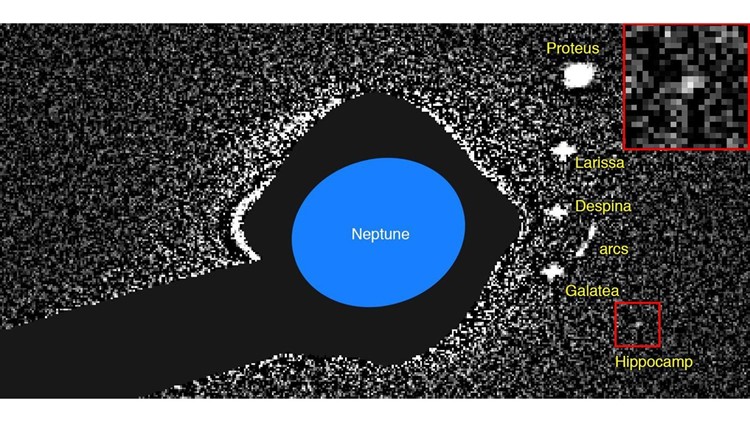For the first time in decades, a new tiny moon has been found in orbit around the gas giant Neptune, according to a study published Wednesday in the journal Nature.
Hippocamp, now known as Neptune’s smallest moon, is named for the sea monster from Greek mythology, said to have a fish’s tail attached to a horse’s body. It’s only about 21 miles in diameter; by comparison, Neptune is 30,599 miles in diameter.
This latest discovery was made by Mark Showalter, a senior research scientist at the SETI Institute, and his team, using observations from the Hubble Space Telescope.
The Voyager 2 spacecraft conducted a flyby of Neptune in 1989 and spotted six small inner moons — but not Hippocamp. This makes Hippocamp the seventh inner moon found around Neptune, bringing the planet’s total moons to 14.
Hippocamp is in close orbit to Proteus, the largest and outermost of Neptune’s inner moons. And the researchers believe that Hippocamp is a fragment of Proteus.
Since the discovery of the small inner moons, scientists have believed that they are younger than Neptune and that they formed after Neptune captured its largest moon, Triton. They also thought these inner moons were fragmented due to impacts by comets.
This discovery adds to that evidence.
Hippocamp orbits within 12,000 kilometers of Proteus, and due to Neptune’s gravity, the two moons have a more outward orbit than the other inner moons. Tiny Hippocamp orbits more slowly than Proteus, though, which suggests that it’s orbiting closer to the area where it initially formed. The researchers believe that Hippocamp and Proteus were even closer together in the past.
Proteus also has an unusually large crater called Pharos, which indicates that a significant impact almost destroyed it long ago. Hippocamp is about 2% of the volume that Proteus is missing, but the other debris could have contributed to the formation of a ring.
The researchers don’t rule out the possibility that Hippocamp formed on its own, but the size and location — as well as the other noticeable impacts on Neptune’s inner moons — suggest that it was formed off of Proteus. They estimate the tiny moon is at least a few billion years old, according to the study.
The technique used to find Hippocamp could help with locating small moons around giant planets in the future. Showalter’s team specializes in finding small moons, and this was no happenstance. The team has also found small moons around Uranus, Saturn and Pluto.
The team’s specialized technique involves processing images from Hubble that enhance the sensitivity of its cameras. The inner moons orbit very quickly, but this technique increases the exposure time. This kind of technique also led other researchers to discover Ultima Thule, the distant Kuiper Belt Object explored by the New Horizons spacecraft during a flyby on New Year’s Day.
“Astronomers have suspected since the 1980s that the small, inner moons of the giant planets get broken apart occasionally by impacts from comets,” Showalter said in an email. “I think Hippocamp provides a dramatic illustration that this idea is correct, because it is hard for us to understand how Hippocamp can be where we find it today unless it is a piece of the larger moon Proteus that was broken off in an impact perhaps 4 billion years ago.”



